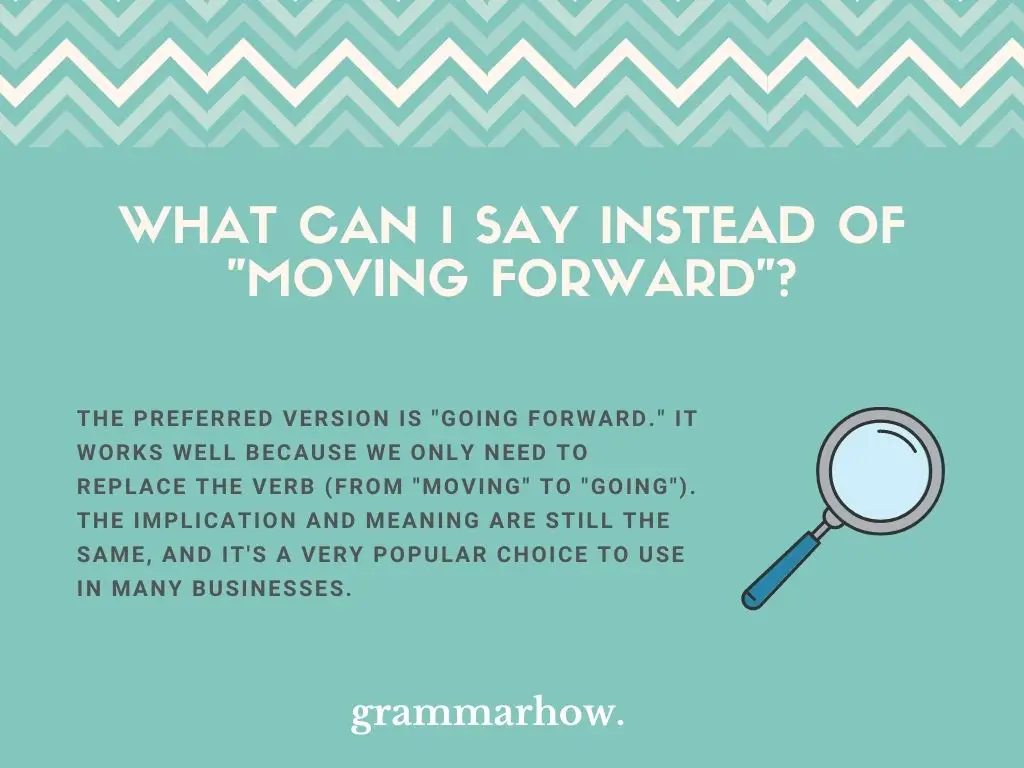zenduck.me: 11 Other Words For Moving Forward
Untung99 menawarkan beragam permainan yang menarik, termasuk slot online, poker, roulette, blackjack, dan taruhan olahraga langsung. Dengan koleksi permainan yang lengkap dan terus diperbarui, pemain memiliki banyak pilihan untuk menjaga kegembiraan mereka. Selain itu, Untung99 juga menyediakan bonus dan promosi menarik yang meningkatkan peluang kemenangan dan memberikan nilai tambah kepada pemain.
Berikut adalah artikel atau berita tentang Harian zenduck.me dengan judul zenduck.me: 11 Other Words For Moving Forward yang telah tayang di zenduck.me terimakasih telah menyimak. Bila ada masukan atau komplain mengenai artikel berikut silahkan hubungi email kami di [email protected], Terimakasih.
“Moving forward” is a useful term in many businesses. They use it to talk about how operations might change in the future. However, there are some other words that you might want to familiarize yourself with. This article will explore some of the alternatives you can use.
What Can I Say Instead Of “Moving Forward”?
There are many other words we can use for “moving forward.” You should try some of the following to see which is your favorite:
- Going forward
- Going ahead
- From this point on
- From now on
- Proceeding
- Progressing
- Advancing
- Moving on from this
- Looking forward
- From here
- In the future

The preferred version is “going forward.” It works well because we only need to replace the verb (from “moving” to “going”). The implication and meaning are still the same, and it’s a very popular choice to use in many businesses.
Going Forward
“Going forward” is the best way to replace “moving forward.” It works well because it sticks to the original idea while also allowing us to use something that feels a little smoother off the tongue. “Go” is a common verb that everyone is familiar with, after all.
Check out these examples to see how it works:
- Going forward, I think you should all be more considerate of each other’s feelings.
- Going forward, I think team-building exercises will be the best way to build morale.
- Going forward, you should not address each other by name.
Going Ahead
“Going ahead” works similarly to “going forward.” It shows how things might be different “going ahead,” meaning that there is a sudden and abrupt change in the present. “Ahead” isn’t as common as “forward,” but both phrases are still used.
Here are some examples:
- Going ahead, I would like you all to report to the offices before you sign in.
- Going ahead, I would like you to send me an email every week about your workload.
- Going ahead, I have made sure to hire a few new people to help with security.
From This Point On
“From this point on” works when we want to show how things might change going forward. “This point” refers to the present, and it means that certain things are likely going to change in the future.
However, while some things change, it does not mean they will change again. “From this point on” does a good job of keeping all the changes consistent until you are given a new update about them.
Here are a few helpful examples:
- From this point on, we will be working extra hard to get the projects completed.
- From this point on, paid overtime will be a thing of the past.
- From this point on, I can no longer grant any of you extra holiday days in the busy period.
From Now On
“From now on” is a good way of showing how things will change at present. It shows that something has been previously considered, and it has now come to a time where someone is willing to start acting on the new rules until told otherwise.
You might benefit from checking out these examples to see it work:
- From now on, I would like you all to arrive at my office ten minutes before I order you to.
- From now on, the CEO will be coming down bimonthly to check on all of the progress we’ve made.
- From now on, you need to deliver at least three new projects a month if you want to keep your payments up.
Proceeding
“Proceeding” is excellent if you’re looking for a one-word synonym for “moving forward.” We can use it because it shows how things might change when we “proceed” from the present. It still considers the future options, which is why it works.
These examples should explain how it can work:
- Proceeding, I think we should all take a little more time to ask how we’re doing.
- Proceeding, there will be a few more team-building meetings every few months.
- Proceeding, we will be looking for ways to keep the workload at the same level without having to hire as many workers.
Progressing
“Progressing” works well if we’re looking for a one-word option similar to “proceeding.” It works because it shows “progress.” This is the idea that something will continually get better, providing that everyone can stick to the new rules or regulations put in place.
Check out these examples to see how it might work:
- Progressing, we should all try to take our lunch breaks exactly when they’re scheduled.
- Progressing, I think it would be wise for us to have 1-2-1 meetings biweekly to check on all of your workloads.
- Progressing, the manager would like for you all to write up your daily quotas and email them to me to verify.
Advancing
“Advancing” is another great one-word choice. We can use it to show how things might change as we “advance” into the future. It’s not the most common word to use, but it’s still suitable in certain situations.
- Advancing, I would like everybody to hand in their weekly quotas.
- Advancing, I would like for you to make sure that you can keep your desks tidier than they are currently.
- Advancing, I think we should all try a little harder to keep team morale up.
Moving On From This
“Moving on from this” is another useful way to replace “moving forward.” It shows that something has taken place in the present and that people should be paying closer attention to it from this moment on.
It helps people to remember that vital changes might be needed in the company. Sometimes, dire situations are more common to lead to a phrase like “moving on from this,” where something was overlooked and went wrong.
These examples will help you to understand it:
- Moving on from this, we are going to make sure that safety precautions are taken more seriously.
- Moving on from this, you will all be rigorously vetted before you can attend any further interviews.
- Moving on from this, we will make sure not to make the same error again.
Looking Forward
“Looking forward” is a good way to show how things might change. This time, we use the verb “looking” to talk about prospective changes, though they may not always become a reality.
It mainly depends on what the new ideas are. If they’re a bit outlandish or in need of testing, a manager might use “looking forward” to remind employees that it’s a possibility, but it is yet to be confirmed.
Here are a few ways we can make this one work:
- Looking forward, we may be able to get a few extra days of holiday per year if we work hard enough.
- Looking forward, we’re going to see whether we can make your lives easier while working for us.
- Looking forward, there are a few different plans that I have that should help us all to streamline the databases.
From Here
“From here” works well to show how things will change as time goes on. The idea is the same as all the other words, where something will take place “now” and continue to take place until some point in the future where you might be updated about something.
Here are a few examples that will help you make more sense of it:
- From here, we do not have much more to do with the old company, and we must focus on the new one.
- From here, you should find that our rules are getting a little stricter, and we will be enforcing them.
- From here, someone should be able to tell you when you’re coming in if you text this number.
In The Future
“In future” is another great way to change “moving forward.” We can use it when we want to show how certain things might change in the future, though they aren’t necessarily going to change “at present.”
While we do not mention the present, the idea is that once we have finished speaking (if we’re in a meeting), the “future” is taking place. That means the new rules or operations should be immediately changed after that point.
Here are some examples:
- In the future, I want you all to make sure you arrive five minutes before your shift starts.
- In the future, please make sure not to clock out until you have checked the time.
- In the future, please check with the rota team before booking any holiday that has not been agreed.
What Does “Moving Forward” Mean?
“Moving forward” means that rules or operations are going to change from this point on. It means that many considerations have been taking place in the past, and it has now been decided to change certain things in the present (and far into the future).
Until you are updated again, you can assume that the new rules “moving forward” will always be the rules you should follow. It’s a good way to show the people that work for you that certain things need to be addressed before any of them can continue.
It’s best to address how things might change “moving forward” in business meetings. This will ensure that everyone understands the new changes and knows how to handle them correctly.

Martin holds a Master’s degree in Finance and International Business. He has six years of experience in professional communication with clients, executives, and colleagues. Furthermore, he has teaching experience from Aarhus University. Martin has been featured as an expert in communication and teaching on Forbes and Shopify. Read more about Martin here.